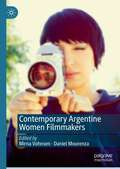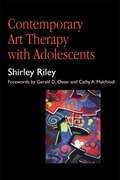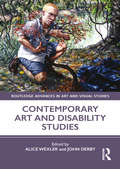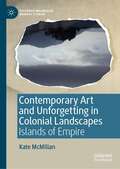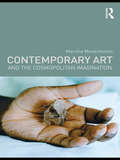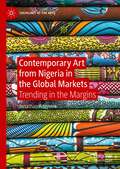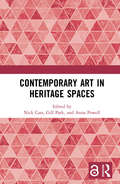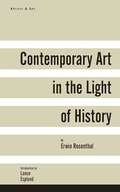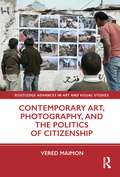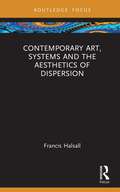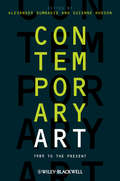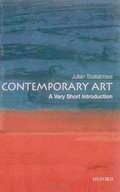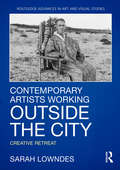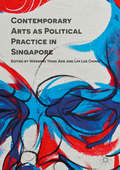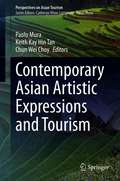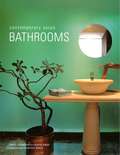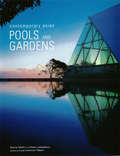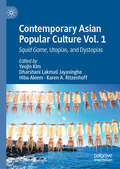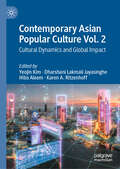- Table View
- List View
Contemporary Argentine Women Filmmakers
by Mirna Vohnsen Daniel MourenzaThis edited volume offers a wide-ranging picture of Argentine women filmmakers’ contribution to the film industry from the 1980s to the present by bringing together the work of highly acclaimed and emerging directors. Through thirteen critical essays by leading scholars in the field of Argentine cinema, the book acknowledges that contemporary women filmmakers have transformed the cinema of Argentina by questioning, challenging and debunking hegemonic patriarchal systems of representation. With a focus on women’s voices and experiences, the contributions redress both the under-representation of women and girls onscreen and the perpetuation of stereotypes, while exploring the innovative aesthetics used by these filmmakers.
Contemporary Art Therapy with Adolescents
by Shirley Riley Cathy A MalchiodiContemporary Art Therapy with Adolescents offers practical and imaginative solutions to the multifaceted challenges that clinicians face when treating young people. The author fuses the contemporary theories of clinical treatment with the creative processes of art therapy to arrive at a synthesis which yields successful outcomes when working with adolescents. Clinicians of allied disciplines, particularly art therapists, will find practical suggestions for using imagery to enrich their relationships with teenaged clients. The process of using art-making therapeutically, and the challenges of applying creativity in the current mental health world, are explored. Shirley Riley reviews current theories on adolescent development and therapy, and emphasizes the primary importance of relying on the youths' own narrative in the context of their social and economic backgrounds. She has found this approach preferential to following pre-designed assessment directives as a primary function of art therapy. Family, group and individual treatment are examined, as is the adolescent's response to short- and long-term treatment in residential and therapeutic school settings. The book is firmly rooted in Riley's clinical experience of working with this age group, and her proven ability to combine contemporary theories of adolescent treatment with inventive and effective art expressions.
Contemporary Art Therapy with Adolescents
by Shirley RileyContemporary Art Therapy with Adolescents offers practical and imaginative solutions to the multifaceted challenges that clinicians face when treating young people. The author fuses the contemporary theories of clinical treatment with the creative processes of art therapy to arrive at a synthesis which yields successful outcomes when working with adolescents. Clinicians of allied disciplines, particularly art therapists, will find practical suggestions for using imagery to enrich their relationships with teenaged clients. The process of using art-making therapeutically, and the challenges of applying creativity in the current mental health world, are explored.Shirley Riley reviews current theories on adolescent development and therapy, and emphasizes the primary importance of relying on the youths' own narrative in the context of their social and economic backgrounds. She has found this approach preferential to following pre-designed assessment directives as a primary function of art therapy. Family, group and individual treatment are examined, as is the adolescent's response to short- and long-term treatment in residential and therapeutic school settings. The book is firmly rooted in Riley's clinical experience of working with this age group, and her proven ability to combine contemporary theories of adolescent treatment with inventive and effective art expressions.
Contemporary Art and Capitalist Modernization: A Transregional Perspective (Routledge Advances in Art and Visual Studies)
by Octavian EsanuThis book addresses the art historical category of "contemporary art" from a transregional perspective, but unlike other volumes of its kind, it focuses in on non-Western instantiations of "the contemporary." The book concerns itself with the historical conditions in which a radically new mode of artistic production, distribution, and consumption – called "contemporary art" – emerged in some countries of Eastern Europe, the post-Soviet republics of the USSR, India, Latin America, and the Middle East, following both local and broader sociopolitical processes of modernization and neoliberalization. Its main argument is that one cannot fully engage with the idea of the "global contemporary" without also paying careful attention to the particular, local, and/or national symptoms of the contemporary condition. Part I is methodological and theoretical in scope, while Part II is historical and documentary. For the latter, a number of case studies address the emergence of the category "contemporary art" in the context of Lebanon, Egypt, India, Hungary, Slovenia, Croatia, Bosnia and Herzegovina, Armenia, and Moldova. The book will be of interest to scholars working in art history, globalism, cultural studies, and postcolonial studies.
Contemporary Art and Disability Studies (Routledge Advances in Art and Visual Studies)
by Alice Wexler John DerbyThis book presents interdisciplinary scholarship on art and visual culture that explores disability in terms of lived experience. It will expand critical disability studies scholarship on representation and embodiment, which is theoretically rich, but lacking in attention to art. It is organized in five thematic parts: methodologies of access, agency, and ethics in cultural institutions; the politics and ethics of collaboration; embodied representations of artists with disabilities in the visual and performing arts; negotiating the outsider art label; and first-person reflections on disability and artmaking. This volume will be of interest to scholars who study disability studies, art history, art education, gender studies, museum studies, and visual culture.
Contemporary Art and Unforgetting in Colonial Landscapes: Islands of Empire (Palgrave Macmillan Memory Studies)
by Kate McMillanThis book explores the work of artists based in the global south whose practices and methods interrogate and explore the residue of Empire. In doing so, it highlights the way that contemporary art can assist in the un-forgetting of colonial violence and oppression that has been systemically minimized. The research draws from various fields including memory studies; postcolonial and decolonial strategies of resistance; activism; theories of the global south; the intersection between colonialism and the Anthropocene, as well as practice-led research methodologies in the visual arts. Told through the author’s own perspective as an artist and examining the work of Julie Gough, Yuki Kihara, Megan Cope, Yhonnie Scarce, Lisa Reihana and Karla Dickens, the book develops a number of unique theories for configuring the relationship between art and a troubled past.
Contemporary Art and the Church: A Conversation Between Two Worlds (Studies in Theology and the Arts)
by W. David Taylor Taylor WorleyContemporary Art and the Church
Contemporary Art and the Cosmopolitan Imagination
by Marsha MeskimmonContemporary Art and the Cosmopolitan Imagination explores the role of art in conceiving and reconfiguring the political, ethical and social landscape of our time. Understanding art as a vital form of articulation, Meskimmon argues that artworks do more than simply reflect and represent the processes of transnational and transcultural exchange typical of the global economy. Rather, art can change the way we imagine, understand and engage with the world and with others very different than ourselves. In this sense, art participates in a critical dialogue between cosmopolitan imagination, embodied ethics and locational identity. The development of a cosmopolitan imagination is crucial to engendering a global sense of ethical and political responsibility. By materialising concepts and meanings beyond the limits of a narrow individualism, art plays an important role in this development, enabling us to encounter difference, imagine change and make possible the new. This book asks what it means to inhabit a globalized world – how we might literally and figuratively make ourselves cosmopolitans, ‘at home’ everywhere. Contemporary art provides a space for this enquiry. Contemporary Art and the Cosmopolitan Imagination is structured and written through four ‘architectonic figurations’ – foundation, threshold, passage and landing – which simultaneously reference the built environment and the transformative structure of knowledge-systems. It offers a challenging new direction in the current literature on cosmopolitanism, globalisation and art.
Contemporary Art from Nigeria in the Global Markets: Trending in the Margins (Sociology of the Arts)
by Jonathan AdeyemiThis book brings together from four years of study on Nigerian contemporary art's internationalization. The monograph integrates voices of African (Nigerian) artists and art market players into the growing discourse on the emerging art markets in the global South. It explores the logic of competition and dynamics of power relations in the global markets, focusing on the internationalization of contemporary art forms from peripheral regions. The book confirms that the internationalization of contemporary art form from Nigeria is limited due to systematic marginalization in the artistic field, which in this case based on postcolonialism, and debilitating socio-economic factors such as outmoded art education, unstructured support system and weak mechanism for local validation, and an inefficient political framework for art governance.It will therefore be useful to students and researchers in the sociology of art, art market studies, art history and culture polity.
Contemporary Art in Heritage Spaces
by Gill Cass Anna Powell Nick ParkContemporary Art in Heritage Spaces considers the challenges that accompany an assessment of the role of contemporary art in heritage contexts, whilst also examining ways to measure and articulate the impact and value of these intersections in the future. Presenting a variety of perspectives from a broad range of creative and cultural industries, this book examines case studies from the past decade where contemporary art has been sited within heritage spaces. Exploring the impact of these instances of intersection, and the thinking behind such moments of confluence, it provides an insight into a breadth of experiences – from curator, producer, and practitioner to visitor – of exhibitions where this juncture between contemporary art and heritage plays a crucial and critical role. Themes covered in the book include interpretation, soliciting and measuring audience responses, tourism and the visitor economy, regeneration agendas, heritage research, marginalised histories, and the legacy of exhibitions. Contemporary Art in Heritage Spaces will be essential reading for academics and students engaged in the study of museum and heritage studies and contemporary art around the globe. Museum practitioners and artists should also find much to interest them within the pages of this volume. Chapter 9 of this book is available for free in PDF format as Open Access from the individual product page at www.routledge.com. It has been made available under a Creative Commons Attribution-Non Commercial-No Derivatives 4.0 license
Contemporary Art in the Light of History (Artists And Art Ser.)
by Deborah Rosenthal Erwin Rosenthal Lance EsplundErwin Rosenthal's Contemporary Art in the Light of History, originally published in 1971, is a small masterpiece of writing on the art of the twentieth century. A scholar of medieval art by training and a prominent antiquarian bookseller, Rosenthal, who died in l981, was equally entranced by modern art, particularly abstraction. His three linked essays in this book--"Contemporary Art in the Light of History," "Art and Technology," and "Art Theories and Manifestos, Old and New"--set out a path to understanding modern art through its affinities with the art of the past.Rosenthal engages with some of the enduring aesthetic questions: How do new forms and new artistic vocabularies respond to the deepest human needs and impulses? What is the relationship between artistic theory and artistic expression? Nicolas Poussin's mythological landscapes, Paul Klee's graphic abstractions, Bridget Riley's op-art compositions--these and many other examples from centuries of painting, sculpture, poetry, and music take us, in these pages, on a fascinating cultural journey with a sophisticated and lucid guide. Rosenthal's explorations of the theory and practice of twentieth-century artists bring us directly into the minds and studios of modern artists. What is more, like his previous The Changing Concept of Reality in Art, already republished by Arcade, this book invites us into a great intimacy with the origins of art.
Contemporary Art, Photography, and the Politics of Citizenship (Routledge Advances in Art and Visual Studies)
by Vered MaimonThis book analyzes recent artistic and activist projects in order to conceptualize the new roles and goals of a critical theory and practice of art and photography. Vered Maimon argues that current artistic and activist practices are no longer concerned with the “politics of representation” and the critique of the spectacle, but with a “politics of rights” and the performative formation of shared yet highly contested public domains. The book thus offers a critical framework in which to rethink the artistic, the activist, and the political under globalization. The primary focus is on the ways contemporary artists and activists examine political citizenship as a paradox where subjects are struggling to acquire rights whose formulation rests on attributes they allegedly don't have; while the universal political validity of these rights presupposes precisely the abstraction of every form of difference, rights for all. The book will be of interest to scholars working in art history, contemporary art, photography theory, visual culture, cultural studies, critical theory, political theory, human rights, and activism.
Contemporary Art, Systems and the Aesthetics of Dispersion (Routledge Focus on Art History and Visual Studies)
by Francis HalsallUsing five case studies of contemporary art, this book uses ideas of systems and dispersion to understand identity and experience in late capitalism. This book considers five artists who exemplify contemporary art practice: Seth Price; Liam Gillick; Martin Creed; Hito Steyerl; and Theaster Gates. Given the diversity of materials used in art today, once-traditional artistic mediums and practices have become obsolete in describing what artists do today. Francis Halsall argues that, in the face of this obsolescence, the ideas of system and dispersion become very useful in understanding contemporary art. That is, practitioners now can be seen to be using whatever systems of distribution and display are available to them as their creative mediums. The two central arguments are first that any understanding of what art is will always be underwritten by a related view of what a human being is; and second that these both have a particular character in late capitalism or, as is named here, the Age of Dispersion. The book will be of interest to scholars and students working in art history, contemporary art, studio art, and theories of systems and networks.
Contemporary Art: 1989 to the Present
by Alexander DumbadzeAn engaging account of today’s contemporary art world that features original articles by leading international art historians, critics, curators, and artists, introducing varied perspectives on the most important debates and discussions happening around the world. Features a collection of all-new essays, organized around fourteen specific themes, chosen to reflect the latest debates in contemporary art since 1989 Each topic is prefaced by an introduction on current discussions in the field and investigated by three essays, each shedding light on the subject in new and contrasting ways Topics include: globalization, formalism, technology, participation, agency, biennials, activism, fundamentalism, judgment, markets, art schools, and scholarship International in scope, bringing together over forty of the most important voices in the field, including Sofía Hernández Chong Cuy, David Joselit, Michelle Kuo, Raqs Media Collective, and Jan Verwoert A stimulating guide that will encourage polemical interventions and foster critical dialogue among both students and art aficionados
Contemporary Art: A Very Short Introduction
by Julian Stallabrass"Bloodied toy soldiers, gilded shopping carts, and Lego concentration camps. Contemporary art is supposed to be a realm of freedom where artists shock, break taboos, and switch between confronting viewers with works of great profundity and jaw-dropping triviality. But away from shock tactics in the gallery, there are many unanswered questions. What is contemporary about contemporary art? What effect do politics and big business have on art? And who really runs the art world?" "Previously published as Art Incorporated, this controversial and witty Very Short Introduction is an exploration of the global art scene that will change the way you see contemporary art."--BOOK JACKET.
Contemporary Artists Working Outside the City: Creative Retreat (Routledge Advances in Art and Visual Studies)
by Sarah LowndesThis book reflects on the motivations of creative practitioners who have moved out of cities from the mid-1960s onwards to establish creative homesteads. The book focuses on desert exile painter Agnes Martin, radical filmmaker and gardener Derek Jarman, and iconoclastic conceptual artist Chris Burden, detailing their connections to the cities they had left behind (New York, London, Los Angeles). Sarah Lowndes also examines how the rise of digital technologies has made it more possible for artists to live and work outside the major art centers, especially given the rising cost of living in London, Berlin, and New York, focusing on three peripheral creative centers: the seaside town of Hastings, England, the midsized metro of Leipzig, Germany, and post-industrial Detroit, USA.
Contemporary Arts as Political Practice in Singapore
by Wernmei Yong Ade Lim Lee ChingThis pivot examines the contemporary arts as political practice in Singapore. Singapore marked 50 years of Independence in 2015 and this timely collection on the topic of contemporary arts as political practice in Singapore offers critical insight into some of the more controversial talking points that have shaped Singapore's identity as a nation. Focusing on the role played by contemporary arts in shaping Singapore's political landscape, the authors consider how Politics is often perceived as that which limits the flourishing of the arts. Contending that all art is political, and that all art form is a form of political practice, this collections examines ways in which the practice of art in Singapore redraws the boundaries that conventionally separate arts from politics. It critically examines the tenuous relationship between the arts and politics and offers a timely reevaluation of the relationship between the arts and politics. In doing so, this collection opens a dialogue between artistic practice and political practice that reinforces the mutuality of both, rather than their exclusivity and redefines the concept of the political to demonstrate that political involvement is not a simple matter of partisan politics, but has an inherently aesthetic dimension, and aesthetics an inherently political one.
Contemporary Asian Artistic Expressions and Tourism (Perspectives on Asian Tourism)
by Paolo Mura Keith Kay Hin Tan Chun Wei ChoyThis book explores the relationship between tourism/tourists and expressions of contemporary Asian art (for example, artists, objects, intangible artistic productions, digital manifestations, etc) in Asian and non-Asian tourist spaces/experiences.Although the nexus between art and tourism has not been neglected in the literature, work on contemporary art and tourism is lacking, and this is particularly true within the context of non-Western societies. This volume creates a timely counterpoint to the existing dominance of a Western-centric body of knowledge in the area.The book considers how encounters between tourists and expressions of Asian contemporary art may produce possibilities for challenging, re-evaluating or reasserting crystallized frames of understanding and, as such, is of value to a multi-disciplinary audience.
Contemporary Asian Bathrooms
by Luca Invernizzi Tettoni Chami Jotisalikorn Karina ZabihiShot entirely on location, Contemporary Asian Bathrooms presents the newest trends emerging in Asian home design. Gorgeous full color photographs showcase the sexy new look and fantasy appeal of today's bathrooms. Featuring one-of-a-kind indoor and outdoor bathroom designs in 50 luxury homes and hotels across Southeast Asia, this book offers homeowners new ideas for showers, tubs, fixtures, tiles and lighting that will inspire a new approach to modern bathing.
Contemporary Asian Bedrooms
by Luca Invernizzi Tettoni Chami Jotisalikorn Karina ZabihiContemporary Asian Bedrooms opens the door to a new world of slumber retreats, showcasing some of the most eye-catching bedroom designs in luxury homes and hotels in Southeast Asia. Shown here are a range of new design trends, from Zen minimalist to exuberant color kaleidoscopes that make contemporary bedrooms more than just a spot for shut-eye. This book gives homeowners and designers a look at new ideas, shapes, colors and textures that transform the places we sleep into high-style, must-have dream spaces.
Contemporary Asian Kitchens and Dining Rooms
by Luca Invernizzi Tettoni Chami Jotisalikorn Karina ZabihiWith over one hundred full-color photographs, Contemporary Asian Kitchens and Dining Rooms looks at a wide range of inspirational cooking and dining spaces, from the elegance of open-plan entertaining to the raw, modern look of an industrial kitchen.Few rooms in the house depict the changing aesthetics of design as radically as kitchens and dining rooms. The growing trend toward modern fixtures and fittings in kitchens calls for more interactive and creative dining areas, a trend that is redefining the Asian home. Innovation and quality leap from every page of this book, which features the work of some of the best architects and designers from Singapore, Thailand, Malaysia and Bali. Special sections on al fresco dining as well as tips on how to create the ultimate in table settings give this book an up-to-the-minute edge. Every design is modern and appropriate for homes from Asia to America.
Contemporary Asian Living Rooms
by Luca Invernizzi Tettoni Chami Jotisalikorn Karina ZabihiContemporary Asian Living Rooms explores 50 of Southeast Asia's most interesting homes and hotels.Interiors range from the starkly minimal to the luxuriously plush - from Singapore. Malaysia, Thailand and Bali. Created by some of the leading talents in contemporary Asian design today, these interiors feature creative shapes, contours, materials and new ways of working with the space where family and friends spend most of their time together.
Contemporary Asian Pools and Gardens
by Luca Invernizzi Tettoni Chami Jotisalikorn Karina ZabihiContemporary Asian Pools and Gardens?showcases the continent's most spectacular modern gardens and water features. Private swimming pools and gardens have increasingly become an integral part of modern living spaces - and you don't necessarily have to live in a house to have one. This book in the Contemporary Asian Home series includes special chapters on walkways, lighting, gates and roof gardens, as well as the latest in infinity, lap and rooftop pools, displaying some of the most sought after designs in the region
Contemporary Asian Popular Culture Vol. 1: Squid Game, Utopias, and Dystopias
by Karen A. Ritzenhoff Yeojin Kim Dharshani Lakmali Jayasinghe Hiba AleemThis first of two volumes explores how contemporary Asian popular culture reflects and critiques social issues. The authors, from different scholarly backgrounds, examine how shows like Squid Game present a scathing critique of oppressive socio-economic structures, conceptualize national heterotopias, utopias, and dystopias, and facilitate understanding of identity formation and discourses of resistance. The volume encompasses chapters discussing themes that intersect gender, race, politics, and social dynamics. It showcases ongoing developments in Asian popular culture in the wake of the global popularity of Squid Game and in anticipation of its second season release in December 2024.
Contemporary Asian Popular Culture Vol. 2: Cultural Dynamics and Global Impact
by Karen A. Ritzenhoff Yeojin Kim Dharshani Lakmali Jayasinghe Hiba AleemThis second of two volumes explores broader cultural, economic, and socio-political dynamics exchanged between Asian popular media and the world. The authors analyze how the said media navigate complex global markets and technological advancements. They discuss how dissemination and consumption of Asian popular culture, such as early Chinese-language movie theaters, Netflix, subtitling of Asian content, impact the popularity of cultural contents. They also examine the portrayal of ajummas (middle-aged women) in Korean TV and film, along with the varying representations of utopia and dystopia embedded in Asian science fiction. This volume illustrates the soft power of media in transnational exchanges.
